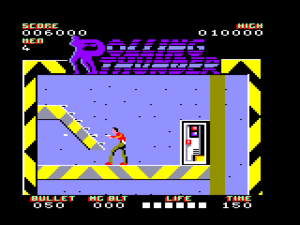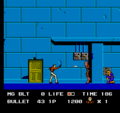Amstrad CPC


Developed by Tiertex and published in Europe by U.S. Gold in 1988.
Atari ST


Developed by Tiertex and published in Europe by U.S. Gold in 1988.
Commodore 64


Developed by Tiertex and published in Europe by U.S. Gold in 1987.
Commodore Amiga


Developed by Tiertex and published in Europe by U.S. Gold in 1988.
Famicom / NES
Although some aspects of each level have been slightly altered, and the graphics have been simplified, the game is considerably faithful to the arcade original. In addition to entering marked doors for ammunition, players can also enter unmarked doors for the possibility of gaining more time, or restoring lost health. Instead of eight bars on the health meter, there are only two, accurately reflecting how many hits the player can sustain. Ammunition is limited to 300 bullets, and the walk away and return trick to gain more ammunition doesn't work. Many of the enemies outfit colors are altered. Mabu's attack pattern is different. Instead of rushing you, he shoots fireballs, alternating between high and low, which can be shot down with bullets. Also, Mabu only appears when you are out of machine gun ammo. While Namco released the game for the Famicom in Japan, Tengen licensed the right to publish the game in the US, but did so without Nintendo's permission, making this an unlicensed cartridge.
-
screenshot
-
Namco Famicom box
-
Tengen NES box
Sinclair ZX Spectrum


Developed by Tiertex and published in Europe by U.S. Gold in 1988.


